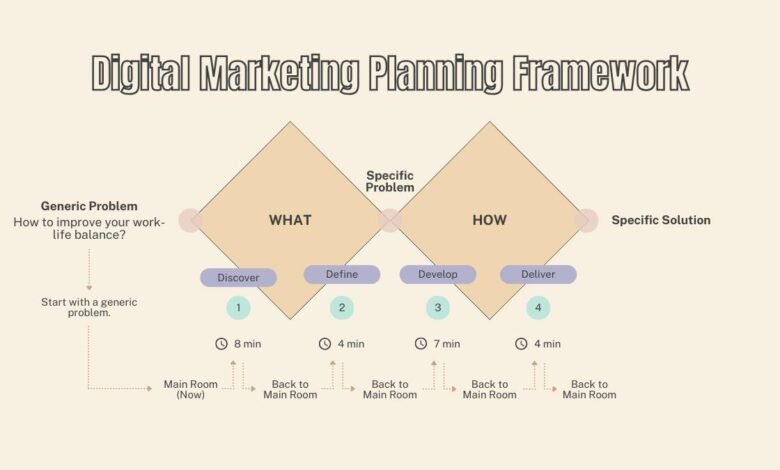Digital Marketing Planning Framework: How to Align Strategy

Digital marketing planning framework, having a solid digital marketing plan is more important than ever. Companies are vying for online visibility, customer engagement. And market share, so it’s essential to have a structured plan that can guide efforts effectively. Digital marketing, unlike traditional marketing, spans multiple channels and technologies, and without a clear framework, efforts can easily become scattered. With the right digital marketing planning framework, businesses can achieve their marketing objectives more efficientl. Providing clarity, direction, and measurable results.
What Digital Marketing Planning Framework?
A digital marketing planning framework is a structured approach that outlines the steps needed to develop, execute, and assess digital marketing campaigns. By providing a roadmap, this framework allows businesses to align their marketing efforts with their overall goals. It helps define specific tasks, targets, and metrics for each phase, ensuring that each component of the marketing strategy contributes to a cohesive whole. For businesses of all sizes, this approach is invaluable for driving growth and maximizing returns on investment.
Setting Strategic Marketing Objectives
Every successful digital marketing plan begins with well-defined objectives. Strategic marketing objectives are clear, measurable goals that align with a company’s mission and vision. These objectives might range from boosting brand awareness to increasing customer retention rates. By setting these targets early in the planning process, companies can ensure that every action taken within the framework serves a purpose and brings the team closer to achieving these overarching goals. Objectives also provide a benchmark to evaluate the effectiveness of campaigns and identify areas for improvement.
Must Visit: Flex Frost
Understanding Customer Journey Mapping
Customer journey mapping is essential to understand how potential customers interact with a brand at every stage of their buying journey. By mapping this journey, companies gain insights into customer needs, preferences, and pain points, allowing them to craft more effective and personalized marketing messages. The process involves identifying each touchpoint, from awareness to purchase and beyond, where customers engage with the brand. With this knowledge, businesses can refine their strategies to improve customer experience, build trust, and ultimately drive conversions.
Content Strategy Development

Content plays a critical role in digital marketing, serving as the foundation of most customer interactions online. A well-crafted content strategy guides the creation, distribution, and management of content to meet marketing objectives. This includes understanding the target audience, identifying their interests, and creating content that speaks to their needs at each stage of the customer journey. From blog posts and social media updates to video and email marketing, each piece of content should be purposeful and aligned with the broader marketing strategy.
Multichannel Marketing Integration
Multichannel marketing is the practice of reaching customers across various platforms, from social media to email, search engines, and websites. By integrating these channels, businesses can create a cohesive brand experience that guides customers seamlessly from one platform to another. Multichannel marketing integration ensures that each touchpoint provides a consistent message and supports the same goals, allowing businesses to maximize engagement and conversions. This unified approach is particularly effective in strengthening brand recognition and improving customer loyalty.
Performance Metrics and Analytics
In digital marketing, data is everything. Performance metrics and analytics are vital tools that allow businesses to measure the success of their campaigns and refine strategies based on real-time feedback. Metrics such as website traffic, conversion rates, social media engagement, and email open rates offer insights into how well the strategy is performing. Regularly analyzing these metrics allows companies to identify what’s working, optimize their campaigns, and make data-driven decisions that drive better results over time.
Building the Framework
Building an effective digital marketing framework involves several key steps. First, companies should conduct thorough market research to understand their audience, competitors, and industry trends. Then, they can set specific objectives and choose the right channels based on where their target audience spends the most time. Each element of the framework should include measurable outcomes, so the company can track progress and make adjustments as needed. Utilizing tools and technology, such as project management software and marketing automation platforms, can streamline the framework’s implementation.
Adapting the Framework for Different Business Sizes
Digital marketing frameworks aren’t one-size-fits-all. For smaller businesses, the framework may be simpler and focus on fewer channels, while larger enterprises might require a more complex, multichannel approach. Regardless of size, flexibility is key. Small businesses might focus more on organic growth and budget-friendly tactics, whereas larger companies can allocate more resources to paid advertising and advanced analytics. Adapting the framework to fit the unique needs and capacities of each business ensures that resources are used efficiently and objectives are achievable.
Setting Up a Budget for Digital Marketing
A well-planned budget is crucial for any digital marketing strategy. By allocating funds across different channels and tactics, businesses can maximize their return on investment while avoiding overspending. Companies should start by evaluating their priorities and estimating the costs of each component of the plan, from content creation and social media advertising to email campaigns and SEO. Budget planning also requires flexibility, as the company may need to adjust spending based on the performance of each channel.
Tools for Effective Digital Marketing Planning
Several tools can assist with different aspects of the digital marketing planning framework. Analytics platforms, such as Google Analytics, provide insights into website traffic and user behavior, while project management tools help teams stay organized and track progress. Social media scheduling tools, like Hootsuite, simplify posting, and CRM platforms, like HubSpot, manage customer data and interactions. By leveraging these tools, companies can increase efficiency, streamline their processes, and make data-driven decisions.
Implementing the Digital Marketing Plan

Once the plan is ready, implementation is the next step. This stage involves executing each component according to the timeline and budget established in the framework. To ensure a smooth rollout, teams should work closely together, monitor initial responses, and make adjustments if necessary. Each team member should understand their role and responsibilities, ensuring a coordinated effort that aligns with the overall objectives. With regular check-ins, businesses can stay on track and make any needed changes as they progress.
Monitoring and Adjusting the Plan
A successful digital marketing plan is never static. Regular monitoring is essential to assess whether the strategy is meeting its goals and to make adjustments as needed. By continuously tracking performance metrics, companies can identify underperforming areas and refine their strategies to achieve better outcomes. This might involve reallocating budget, revising content, or exploring new channels. Monitoring and adjusting ensure that the plan remains relevant and effective in a constantly evolving digital landscape.
Case of Successful Digital Marketing Plans
Many companies have achieved great success with a structured digital marketing framework. For instance, a well-known e-commerce brand used customer journey mapping to identify points of friction in their sales funnel, leading to a 20% increase in conversions. Another example involves a SaaS company that leveraged multichannel marketing integration, resulting in improved brand consistency and a 30% boost in customer engagement. These case studies demonstrate the power of a well-executed framework and the value of learning from successful strategies.
Conclusion
In today’s complex digital landscape, a well-thought-out digital marketing planning framework is essential. By setting clear objectives, understanding the customer journey, developing a strong content strategy, and integrating multiple channels, businesses can create a roadmap for success. With regular monitoring and adjustment, the framework ensures that every effort contributes to the overarching marketing goals. Ultimately, a structured approach to digital marketing helps companies reach their target audience more effectively, build brand loyalty, and achieve sustainable growth.
FAQs
What are strategic marketing objectives?
Strategic marketing objectives are specific, measurable goals aligned with a company’s mission and vision, guiding the direction of the marketing efforts.
Why is customer journey mapping important?
Customer journey mapping helps businesses understand how customers interact with their brand, allowing for more personalized and effective marketing strategies.
What does multichannel marketing integration mean?
Multichannel marketing integration involves coordinating marketing efforts across different channels to provide a consistent and cohesive brand experience.
How can performance metrics improve digital marketing?
Performance metrics provide insights into campaign effectiveness, enabling businesses to make data-driven decisions and optimize their strategies.
What are some tools for digital marketing planning?
Popular tools include Google Analytics for tracking, Hootsuite for social media management, and HubSpot for customer relationship management.
Read More: Automated Crypto Trading Platforms




